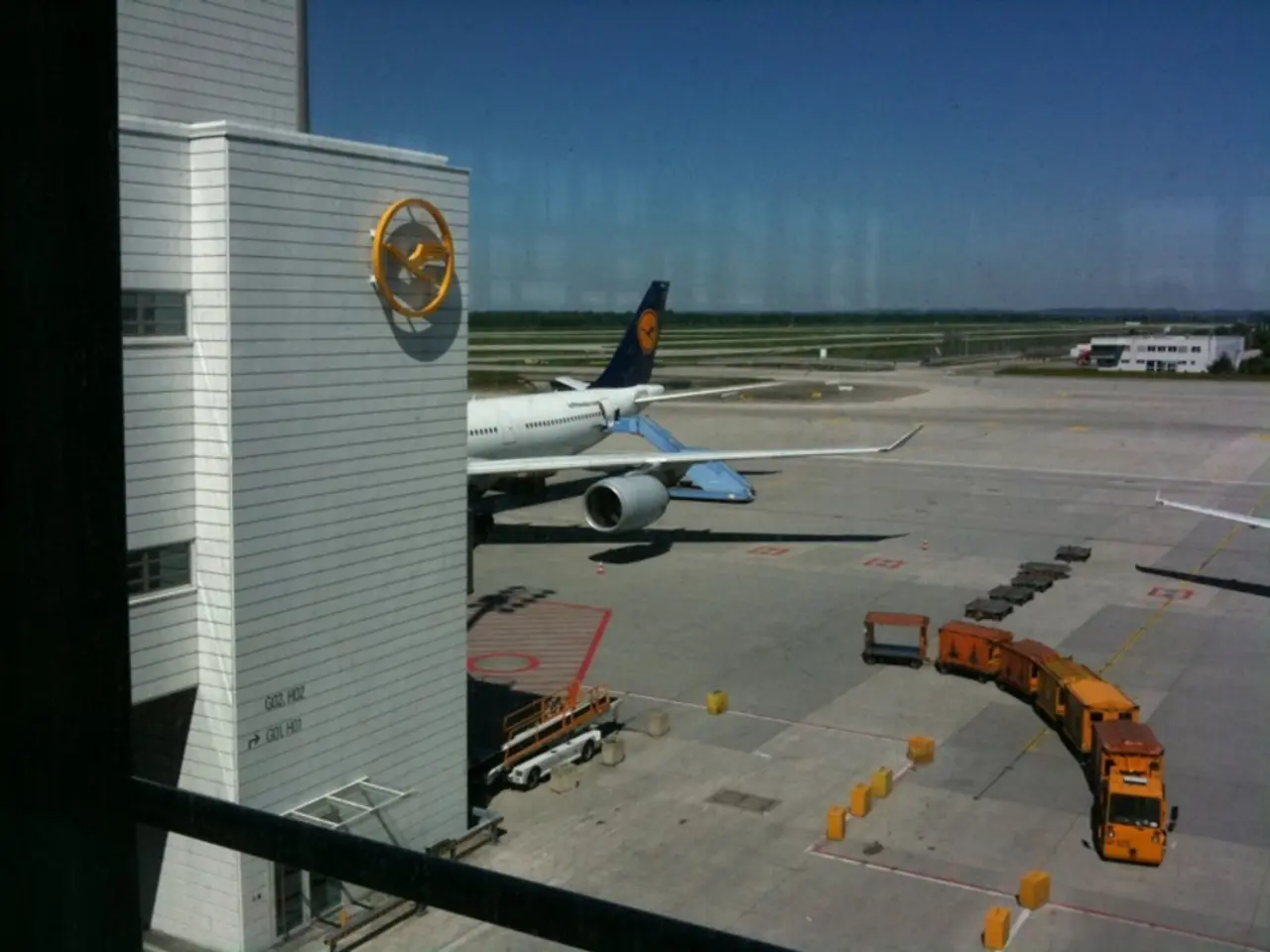Reduction of aircraft's direct carbon emissions by utilizing Eco-friendly Aviation Fuel, as adopted by Airbus.
Airbus, a leading aerospace company, is making strides towards sustainable aviation by embracing Sustainable Aviation Fuels (SAF). Since 2019, Airbus Transport International (ATI) has been using SAF for its Beluga fleet, transporting components and delivering satellites, military cargo, and humanitarian aid.
Airbus is committed to reducing the environmental footprint of its products and services, as part of its pursuit of sustainable aerospace. The company's current strategy to cut carbon emissions by 2030 revolves significantly around the scaling use of SAF, along with fleet renewal and operational improvements.
Fleet Renewal and SAF Adoption
Airbus is renewing its aircraft fleet to incorporate more fuel-efficient models, a foundational step towards reducing carbon emissions. In addition, the company is actively participating in collaborative efforts to develop and use SAF.
Recent partnerships include initiatives to produce SAF locally in countries like France and Indonesia with the goal of significantly scaling production—up to 100 million tonnes in Indonesia from biomass sources. Airbus supports the first long-haul flights using SAF produced in France as part of this initiative, emphasizing SAF as the main medium-term tool for emission reduction.
Tracking and Reporting
Airbus is refining methodologies to accurately track SAF uptake in its fleet and improve lifecycle emissions accounting. The company is making ongoing efforts to better quantify Scope 3 emissions (indirect emissions in their supply chain and product use). By 2024, Airbus intends to refine emissions computations as data quality improves and integrate mass-based information on emissions.
Industrial and Regulatory Engagement
Airbus is involved in wider European and industrial initiatives for SAF regulation and market development, aiming to position Europe, including France, as a strong SAF producer and export leader by 2030. This includes collaboration with governments to accelerate SAF uptake and production capacity despite regulatory complexities.
Production and Delivery Goals
While managing production challenges such as engine supply chain constraints, Airbus plans to increase production rates of key fuel-efficient aircraft models (A320 family and A350) through 2027-2028, supporting the broader transition to lower emissions aviation through modern fleets.
Expansion of SAF Use
Airbus is expanding the use of SAF at two more facilities: Toulouse, France, and Tianjin, China. By the end of this decade, all Airbus manufacturing sites calling on the logistic services of ATI could be supplied with SAF. Teams at these new locations are collaborating with local authorities and suppliers to increase the availability and use of sustainable jet fuel for internal operations.
Notably, Airbus's Employee Shuttle service is now using a 34 percent 'drop-in' SAF blend, provided by Volotea, on a regional jet connecting Airbus Hamburg-Finkenwerde Airport and Toulouse-Blagnac Airport.
Testing and Implementation
SAF adoption is occurring on Airbus sites, contributing to the company's efforts to reduce its carbon footprint. The use of 100% SAF has been tested on the A350 (ECLIF) and the A320 (VOLCAN) for in-flight emissions testing. Airbus Production Flights are now being carried out with SAF as part of serial production aircraft test procedures.
SAF, technically certified to international specifications and standards, can substitute Conventional Aviation Fuel (CAF) and be used as a standard fuel without modifications to an aircraft's structure or systems. This SAF blend has upwards of 80% GHG emissions reduction.
In summary, Airbus's strategy to reduce carbon emissions by 2030 relies heavily on accelerating SAF adoption, renewing its aircraft fleet, and collaborating with industrial and governmental partners to grow SAF production capacity. They have demonstrated early progress with operational tests and long-haul flights using SAF and are improving emissions tracking to support their decarbonization goals.
[1] Airbus (2021). Airbus's ambition to reduce its carbon footprint. Retrieved from https://www.airbus.com/newsroom/press-releases/en/2021/05/airbus-ambition-reduce-carbon-footprint.html
[2] Airbus (2021). Airbus Sustainability Report 2020. Retrieved from https://www.airbus.com/content/dam/airbus/corporate/pdfs/investor-relations/reports/airbus-sustainability-report-2020.pdf
[3] Airbus (2021). Airbus's sustainability strategy. Retrieved from https://www.airbus.com/corporate/sustainability/strategy/index.html
[4] Airbus (2021). Airbus's carbon footprint reduction targets. Retrieved from https://www.airbus.com/corporate/sustainability/reducing-our-carbon-footprint/index.html
- Airbus, in its pursuit of sustainable aerospace, is not only renewing its aircraft fleet with more fuel-efficient models but also actively participating in collaborative initiatives to develop and use SAF, such as local production in France and Indonesia.
- The company is refining methodologies to accurately track SAF uptake in its fleet and improve lifecycle emissions accounting, and aims to refine emissions computations as data quality improves and integrate mass-based information on emissions by 2024.
- Airbus is expanding the use of SAF at two more facilities: Toulouse, France, and Tianjin, China, with intentions to supply all Airbus manufacturing sites that use ATI's logistic services with SAF by the end of this decade.
- Airbus is committed to reducing the environmental footprint of its products and services, and this includes the use of SAF for its Beluga fleet, which transports components and delivers satellites, military cargo, and humanitarian aid.
- Notably, Airbus's Employee Shuttle service is now using a 34 percent SAF blend, provided by Volotea, on a regional jet connecting Airbus Hamburg-Finkenwerde Airport and Toulouse-Blagnac Airport, demonstrating early progress with SAF adoption and contributing to the company's decarbonization goals.




